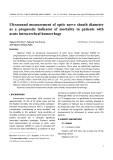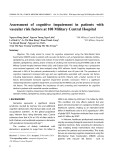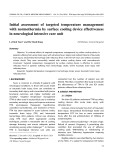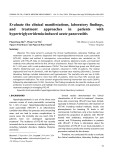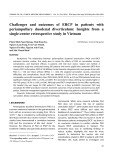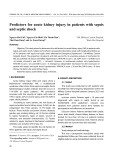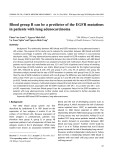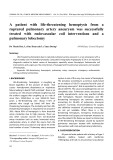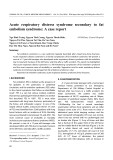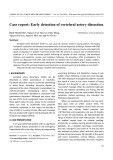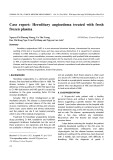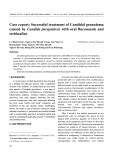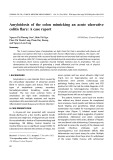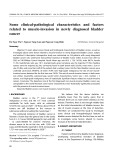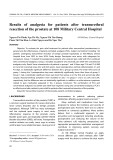Phylogenetic comparison and classification of laccase and related multicopper oxidase protein sequences Patrik J. Hoegger1, Sreedhar Kilaru1, Timothy Y. James2, Jason R. Thacker2 and Ursula Ku¨ es1
1 Georg-August-University Go¨ ttingen, Institute of Forest Botany, Go¨ ttingen, Germany 2 Duke University, Department of Biology, Durham, NC, USA
Keywords basidiomycetes; evolution; phylogeny; wood decay; white rot
Correspondence P. J. Hoegger, Georg-August-University Go¨ ttingen, Institute of Forest Botany, Buesgenweg 2, 37077 Go¨ ttingen, Germany Fax: +49 551392705 Tel: +49 5513914086 E-mail: phoegge@gwdg.de Website: http://wwwuser.gwdg.de/(cid:1)uffb/ mhb/
A phylogenetic analysis of more than 350 multicopper oxidases (MCOs) from fungi, insects, plants, and bacteria provided the basis for a refined classification of this enzyme family into laccases sensu stricto (basidiomyc- etous and ascomycetous), insect laccases, fungal pigment MCOs, fungal ferroxidases, ascorbate oxidases, plant laccase-like MCOs, and bilirubin oxidases. Within the largest group of enzymes, formed by the 125 basidi- omycetous laccases, the gene phylogeny does not strictly follow the species phylogeny. The enzymes seem to group at least partially according to the lifestyle of the corresponding species. Analyses of the completely sequenced fungal genomes showed that the composition of MCOs in the different spe- cies can be very variable. Some species seem to encode only ferroxidases, whereas others have proteins which are distributed over up to four differ- ent functional clusters in the phylogenetic tree.
Database Protein sequence alignments are available in the EMBL-ALIGN database under the acces- sion numbers ALIGN_000939 and ALIGN_000940
(Received 24 October 2005, revised 17 March 2006, accepted 23 March 2006)
doi:10.1111/j.1742-4658.2006.05247.x
laccases
(EC 1.10.3.2),
the amino acid ligands,
Multicopper oxidases (MCOs) are a family of enzymes ferroxidases comprising (EC 1.16.3.1), ascorbate oxidase (EC 1.10.3.3), and ceruloplasmin. This family in turn belongs to the highly diverse group of blue copper proteins which contain from one to six copper atoms per molecule and about 100 to > 1000 amino acid residues in the single peptide chain [1]. MCOs have the ability to cou- ple the oxidation of a substrate with a four-electron reduction of molecular oxygen to water. The electron transfer steps in these redox reactions are coordinated in two copper centres that usually contain four copper atoms. In a redox reaction catalyzed by an MCO, elec-
trons from the substrate are accepted in the mononu- clear centre (type 1 copper atom) and then transferred to the trinuclear cluster (one type 2 and two type 3 copper atoms), which serves as the dioxygen binding site and reduces the molecular oxygen upon receipt of four electrons. The type 1 copper is bound to the enzyme by two histidine and one cysteine residue in the T1 centre, whereas eight histidine residues in the T2 ⁄ T3 cluster serve as ligands for the type 2 and type 3 copper atoms [2–5]. Based on the conservation of two consensus patterns (G-X-[FYW]-X-[LIVMFYW]-X-[CST]-X8-G-[LM]-X3- [LIVMFYW] and H-C-H-X3-H-X3-[AG]-[LM]) were
Abbreviations ABTS, 2,2¢-azinobis(3-ethylbenzo-6-thiazolinesulfonic acid); DHN, 1,8-dihydroxynaphthalene; L-DOPA, 3,4-dihydroxyphenylalanine; LMCO, laccase-like multicopper oxidase; MCO, multicopper oxidase.
FEBS Journal 273 (2006) 2308–2326 ª 2006 The Authors Journal compilation ª 2006 FEBS
2308
P.J. Hoegger et al.
Phylogeny of multicopper oxidases
defined for the MCOs (PROSITE PDOC00076, http:// us.expasy.org/prosite/). Compared with other members of the MCO family, ceruloplasmin, responsible for iron homeostasis in vertebrates, is rather unusual, as it has five to six copper atoms per molecule [6]. Therefore, this enzyme will not be further discussed in this paper. Laccases in the broader sense by far make up the largest subgroup of MCOs, originating from bacteria, fungi, plants, and insects. Laccase was first discovered in the sap of the Japanese lacquer tree Rhus vernicifera [7], hence the name. Subsequently, laccases were also found in various basidiomycetous and ascomycetous fungi and, until now, the fungal laccases account for the most important group with respect to number and extent of characterization.
role in the oxidation of toxic compounds in the diet and ⁄ or in the iron metabolism has been proposed [32]. Laccases have only recently been discovered in bac- teria and their classification and function are still con- troversial. The first report of a bacterial laccase was from the Gram-negative soil bacterium Azospirillum lipoferum [33] and the enzyme was suggested to be involved in melanization [34]. The Bacillus subtilis endospore coat protein CotA is a laccase required for the formation of spore pigment [35] and was recently shown to have also bilirubin oxidase (EC 1.3.3.5) activity [36]. Other bacterial MCOs like the copper efflux protein CueO from Escherichia coli and the cop- per resistance protein CopA from Pseudomonas syrin- gae and Xanthomonas campestris were considered pseudo-laccases due to the dependence of the 2,6- dimethoxyphenol oxidation on Cu2+ addition [37].
This plethora of functions of the various laccases implicates the capability of oxidizing a wide range of substrates, which by the use of mediators (oxidizable low-molecular-weight compounds) can even be greatly extended [38]. Therefore, laccases are very interesting enzymes for various biotechnological applications. Most of the proposed uses for laccases are based on the ability to produce a free radical from a suitable substrate. The multifaceted consecutive secondary reac- tions of the radicals are responsible for the versatility of possible applications [39].
Laccases were found in almost all wood-rotting fungi analyzed so far [8]. It has become evident that laccases can play an important role in lignin degrada- tion [9] even though one of the strongest lignin degra- ding species, Phanerochaete chrysosporium, does not produce a typical laccase [10]. The precise function of is still poorly the enzyme in this process, however, understood [9,11]. Besides delignification, fungal lac- cases have been associated with various organismal interactions (intra- and interspecific) and developmen- tal processes such as fruiting body formation [12,13], pigment formation during asexual development [14,15], pathogenesis [16–18], competitor interactions [19]. Lac- cases of saprophytic and mycorrhizal fungi have also been implicated in soil organic matter cycling, e.g. deg- radation of soil litter polymers or formation of humic compounds [20,21].
A novel MCO with weak laccase and strong ferroxi- dase activity was identified in P. chrysosporium [10]. Ferroxidase activity was also detected in a heterolo- gously expressed laccase from Cryptococcus neoformans [40]. The role of ferroxidase has been analyzed exten- sively in Saccharomyces cerevisiae. The yeast ferroxi- dase Fet3p is a plasma membrane protein that, along with the iron permease Ftr1p, is part of a high affinity iron uptake system [41]. Next to its function in iron metabolism, a protective role by suppressing copper and iron cytotoxicity has been suggested [42].
Several lines of evidence (capacity to oxidize lignin precursors, localization in lignifying xylem cell walls, higher expression in xylem compared to other tissues) suggest the involvement of plant laccases in the lignifi- cation process [22–25]. However, given the complexity of the laccase gene families in plant species, additional, so far not specified functions unrelated to lignin for- mation have been proposed [26]. Due to the ferroxi- dase activity of the MCO LAC2-2 from Liriodendron tulipifera and expression studies of the Arabidopsis thaliana laccase gene family, the term ‘laccase-like multicopper oxidases’ or LMCOs was introduced in order to account for their potential multiplicity of functions [27,28]. All 17 of the A. thaliana LMCOs were shown to be expressed and the expression pat- terns suggested that LMCO function in A. thaliana probably extends well beyond lignification [28].
Ascorbate oxidase catalyzes the oxidation of ascor- bic acid to monodehydroascorbate. However, its spe- cificity is not as strict, as it was shown to oxidize also phenolic substrates typical for laccases [43]. Despite extensive studies on structure, biochemistry, and expression of ascorbate oxidase in plant cells, the phy- siological roles remained uncertain [44]. Ascorbate oxidase was suggested to modify the apoplastic redox state and thereby regulate growth and defence [44]. De Tullio et al. [45] proposed a function in dioxygen man- agement during photosynthesis, fruit ripening, and wound healing.
With the availability of genomic sequences, a multi- tude of genes putatively coding for MCOs has been
In insects, laccases seem to play an important role in cuticular sclerotization [29,30]. In Drosophila melano- gaster, a role in the melanization pathway during the insect’s immune response [31] and in Manduca sexta a
FEBS Journal 273 (2006) 2308–2326 ª 2006 The Authors Journal compilation ª 2006 FEBS
2309
P.J. Hoegger et al.
Phylogeny of multicopper oxidases
92
basidiomycete laccases
laccases sensu stricto
ascomycete laccases
75
90
insect laccases
Cel NP 501502
64
fungal pigment MCOs (melanin DHN1)
fungal ferroxidases
Mgr Mco7
83
Sce AAB64948
97
Cgl XP 448078
Kla XP 452271
57
plant and fungal ascorbate oxidases
plant LMCOs
98
Pch AAO42609 MCO1
83
Pch AAS21669 MCO4 Pch AAS21659 MCO2
99
Pch AAS21662 MCO3 Mgr Mco1
"ferroxidases/laccases"
Fgr Mco1 Uma Mco1 Ego NP 984335 Uma Mco3
Cne Mco5
99
60
Cne A36962 Cne Mco6 Cim Mco2
97
Fgr Mco10 CopA Mtu CAA17652 Mbb NP 854527
99
Rca AAC16140 99
v a r i o u s
99
Bha BAB05801 Bha AAP57087 Lbh1 Ppu AAD24211 CumA Psy AAO54977 CumA
69
Rsc NP 523089
97
Xfa NP 299954
97
Ret NP 660002
Mme AAF75831 PpoA
96
bilirubin oxidases2
b a c t e r i a l s e q u e n c e s w
70
Cje CAB73936
i t h
p r o p o s e d f u n c t i o n s
Tth AAS81712
60
Bsu AAL63794
Aae AAC07157 SufI
61
CueO
99
0.1
Fig. 1. Neighbour joining tree of multicopper oxidase amino acid sequences. Sequences without accession number were derived from the genome sequences (see Experi- mental procedures). Bootstrap values are from 500 replications, only values ‡ 50% are shown (1) including enzymes involved in melanin synthesis by the 1,8-dihydroxy- naphtalene (DHN) pathway, and (2) including two sequences from ascomycetes.
identified. However, from only a small part of these genes the product has been identified or even charac- terized. McCaig et al. [28] proposed to categorize plant LMCOs on the basis of sequence similarity and phylo- genetic analysis until specific physiological functions are defined. They presented a classification of plant
LMCO sequences and, together with expression pro- files, provided strong evidence that most LMCOs from A. thaliana are not involved in lignification but may play a role in iron or other metal metabolisms. In laccases into order to characterize plant and fungal sequences, distinct
subgroups based on signature
FEBS Journal 273 (2006) 2308–2326 ª 2006 The Authors Journal compilation ª 2006 FEBS
2310
P.J. Hoegger et al.
Phylogeny of multicopper oxidases
et al.
or
filamentous
cinnabarinus, Rhizoctonia
[46] analyzed over 100 laccase-like Kumar sequences. Here we present phylogenetic analyses and a classification of over 350 MCO sequences, including laccases, ascorbate oxidases, ferroxidases, and other, not clearly assigned proteins from the animal, plant, fungal, and bacterial kingdom.
for
references
Results and discussion
MCO phylogenetic tree overview
ascomycete homobasidiomycete sequences, respectively (Fig. 1). The former cluster included all the well characterized basidiomycete lac- cases (e.g. from Coprinopsis cinerea, Pleurotus ostrea- solani, tus, Pycnoporus Trametes see Table 1) sp., Fig. 2A, referred to as bona fide laccases [48]. The latter contained most of the reported ascomycete laccases (from Aspergillus terreus [49], Botrytis cinerea [50], Cryphonectria parasitica [18], Gaeumanomyces graminis [51], Melanocarpus albomyces [52], Neurospora crassa [53], and Podospora anserina [54], as well as several previously undescribed sequences we deduced from whole genome sequences (Fig. 2B). Similarly, all insect sequences grouped together (Fig. 2C). Although the enzymatic activity-sequence link has been established for none of these animal sequences yet, expression data suggest that some of the enzymes included here are involved in cuticular sclerotization [32].
The fungal pigment MCO cluster included sequences from filamentous ascomycetes, ascomycetous yeasts and from basidiomycetes (Fig. 2D). It contained the enzymes YA from Aspergillus nidulans and Abr2p from A. fumigatus, both of which are required in conidial pigment biosynthesis [14,15]. More specifically, Abr2p was suggested to be involved in a DHN-melanin (named for the pathway intermediate 1,8-dihydroxy- naphthalene) biosynthesis pathway [15]. YA has been named a laccase because of its ability to oxidize typical laccase substrates such as p-phenylenediamines, pyro- gallol, and gallic acid, however, no data on enzyme kinetics are available [14].
After the different search and selection processes, a total of 271 MCO amino acid sequences were obtained from the NCBI GenBank. Another 90 sequences were retrieved from the publicly available genomic sequences of basidiomycetous and ascomycetous fungi (see Experi- mental procedures), resulting in a total number of 361 sequences. The sequences cover various taxonomic groups. The 258 fungal sequences make up more than two thirds of all sequences. They were derived from 38 different basidiomycete, 30 ascomycete, and one zyg- omycete species. Further, a total of 62 plant sequences (from one gymnosperm, 12 dicotyledon angiosperms, and two monocotyledon angiosperms), 12 animal (from one nematode and four insect species), and 29 prokary- otic sequences (from one archaea, 17 Gram-negative, and six Gram-positive bacteria) were included in the analysis. In order to analyze the similarities among these sequences, we used the neighbour joining method with different distance estimation models (see Experimental procedures) to construct phylogenetic trees based on the manually adjusted ClustalX alignment. Clades consis- tent among trees were assigned and named according to included sequences with known functions and ⁄ or enzy- matic characteristics (Fig. 1, only tree based on the JTT model shown). Based on the main clusters we propose the following classification of MCOs (see below): lac- cases sensu stricto (basidiomycetous and ascomycetous), insect laccases, fungal pigment MCOs, fungal ferroxid- ases, ascorbate oxidases, plant LMCOs, bilirubin oxid- ases. Nakamura and Go [47] recently presented a comparison of blue copper proteins (including the MCOs) and proposed an evolutionary scenario creating the molecular diversity in this diverse assemblage of proteins. Focusing on the MCOs only, our analysis yielded a more resolved phylogeny of the MCO sequences, providing the base for the (putative) func- tional assignment of sequences.
taxonomical association of
One of the most obvious features of the tree was the laccase sensu stricto sequences clustered that the according to the corresponding species. The fungal laccases were clearly separated in two clusters containing either exclusively
The fungal ferroxidase cluster comprised sequences from ascomycetous yeasts, filamentous ascomycetes and basidiomycetes (Fig. 2E). It included the charac- terized Fet3 ferroxidases from the yeasts Arxula adeni- nivorans, Candida albicans, and S. cerevisiae [55–57] and the sequence from gene abr1 neighbouring the putative laccase gene abr2 in a gene cluster for conidial pigment synthesis in Aspergillus fumigatus [15]. In the neighbour joining tree based on p-distances, the ferr- oxidase cluster included three additional sequences (Ego_NP_984335, Fgr_Mco1, Mgr_Mco1) compared to the PAM and JTT trees (not shown). These three sequences belong to a grade of sequences whose group- ing was not consistently supported between the differ- ent trees. We marked them ‘ferroxidases ⁄ laccases’ (in quotes to differentiate this grade from clusters ⁄ clades) due to the presence of Mco1 from P. chrysosporium [10] and a laccase from C. neoformans, shown to polymerize 3,4-dihydroxyphenylalanine (l-DOPA) in melanin synthesis [17,58]. These two enzymes were shown to have both strong ferroxidase and weak
FEBS Journal 273 (2006) 2308–2326 ª 2006 The Authors Journal compilation ª 2006 FEBS
2311
P.J. Hoegger et al.
Phylogeny of multicopper oxidases
typical
sequences:
laccases laccase activities and are thus not [10,40]. This grade also included sequences from fila- mentous ascomycetes (Fig. 1).
Plant and fungal ascorbate oxidase
acid)]
sequences grouped together separate from the laccase or ferroxi- dase clusters (Fig. 1). These sequences were further divided into three closely related subclusters: one with characterized and predicted plant ascorbate oxidases [4,59,60], the second with predicted sequences from the zygomycete Rhizopus oryzae, and the third with the so far sole reported fungal ascorbate oxidase Asom from Acremonium sp. HI-25 [61]. Further sequences in the latter subcluster originated from other filamentous ascomycetes and from the basidiomycete Ustilago may- dis (Fig. 2F).
The cluster with the sequences of characterized lac- cases or LMCOs from the plants Acer pseudoplatanus, L. tulipifera, and Populus trichocarpa [23,62,63] inclu- ded exclusively plant sequences (Fig. 2G).
The bacterial sequences grouped clearly separate from almost all eukaryotic proteins. Two clusters were obvious among the Eubacteria sequences, consisting of copper resistance proteins (CopA, Fig. 2H) and cop- per efflux proteins (CueO, Fig. 2J), respectively [64]. Only one Archaea and two fungal sequences were
the undescribed among the eubacterial MCO from the hyperthermophilic Pyrobaculum aero- philum, the bilirubin oxidase from the ascomycete Myrothecium verrucaria [65], and the closely related phenol oxidase from the ascomycete Acremonium murorum [66]. The two fungal sequences belong to the third cluster among the bacterial sequences assigned as bilirubin oxidases (Fig. 2I) due to the correspond- ing activities described for CotA from B. subtilis [36] and bilirubin oxidase from M. verrucaria [65]. The lat- ter enzyme is a MCO oxidizing bilirubin to biliverdin, laccase substrates like ABTS [2,2¢- but also typical or azinobis(3-ethylbenzo-6-thiazolinesulfonic syringaldazine [67]. It was found in a screen of micro- organisms for decolourization of urine and faeces (containing bilirubin) in raw sewage [68]. The biologi- cal role of bilirubin oxidase activity, however, is not known. Biliverdin is the chromophore of bacteriophyt- ochromes, homologues of which were found in fungi, and it is also a precursor molecule in chromophore synthesis of plant and cyanobacterial phytochromes [69,70]. Due to the lack of experimental data, how- ever, any connection between the chromophores (syn- thesis or degradation) and bilirubin oxidase remains purely speculative.
Fig. 2. Details of clusters from Fig. 1. Sequences without accession number were derived from the genome sequences (see Experimental procedures). Bootstrap values are from 500 replications, only values ‡ 50% are shown. (A) Basidiomycete laccases, (B) ascomycete lac- cases, (C) insect laccases, (D) fungal pigment MCOs (melanin DHN), (E) fungal ferroxidases, (F) fungal and plant ascorbate oxidases, (G) plant LMCOs, (H) CopA (copper resistance), (I) bilirubin oxidases, and (J) CueO (copper efflux). Asterisks in (E) mark the ferroxidases where the corresponding genes are arranged in a mirrored tandem with an iron permease homologue. Note: Cgo_Mco3, Clu_Mco2, Ctr_Mco1, Ctr_Mco2, and Ctr_Mco3 with frame shifts in the genomic sequences. Species codes: Aad, Arxula adeninivorans; Aae, Aquifex aeolicus; Aau, Auricularia auricula-judae; Abi, Agaricus bisporus; Afu, Aspergillus fumigatus; Aga, Anopheles gambiae; Amu, Acremonium murorum; Ani, Emericella nidulans; Apo, Auricularia polytricha; Aps, Acer pseudoplatanus; Asp-HI, Acremonium sp. HI-25; Ate, Aspergillus terreus; Ath, Arabidopsis thaliana; Bci, Botryotinia fuckeliana; Bha, Bacillus halodurans; Bpe, Bordetella pertussis; Bsu, Bacillus subtilis; Cal, Candida albi- cans; Cci, Coprinopsis cinerea; Cco, Coprinellus congregatus; Ccr, Caulobacter crescentus; Ccv-EN, Cucurbita cv. Ebisu Nankin; Cel, Caenor- habditis elegans; Cga, Coriolopsis gallica; Cgl, Candida glabrata; Cgo, Chaetomium globosum; Cgu, Candida guilliermondii; Cim, Coccidioides immitis; Cje, Campylobacter jejuni; Cla, Colletotrichum lagenarium; Clu, Candida lusitanae; Cma, Cucurbita maxima; Cme, Cucumis melo; Cne, Filobasidiella neoformans; Cpa, Cryphonectria parasitica; Csa, Cucumis sativus; Csu, Ceriporiopsis subvermispora; Ctr, Candida tropical- is; Dha, Debaryomyces hansenii; Dme, Drosophila melanogaster; Eco, Escherichia coli; Ego, Ashbya gossypii; Fgr, Gibberella zeae; Ftr, Funa- lia trogii; Fve, Flammulina velutipes; Gar, Gossypium arboreum; Ggg, Gaeumannomyces graminis var. graminis; Ggt, Gaeumannomyces graminis var. tritici; Glu, Ganoderma lucidum; Gma, Glycine max; Kla, Kluyveromyces lactis; Led, Lentinula edodes; Lpe, Lolium perenne; Ltu, Liriodendron tulipifera; Mal, Melanocarpus albomyces; Mbb, Mycobacterium bovis ssp. bovis; Mgr, Magnaporthe grisea; Mme, Marino- monas mediterranea; Mse, Manduca sexta; Mtr, Medicago truncatula; Mtu, Mycobacterium tuberculosis; Mve, Myrothecium verrucaria; Ncr, Neurospora crassa; Nta, Nicotiana tabacum; Oih, Oceanobacillus iheyensis; Osa, Oryza sativa (japonica cultivar-group); Pae, Pyrobaculum aerophilum; Pan, Podospora anserina; Pbt, Populus balsamifera ssp. trichocarpa; Pch, Phanerochaete chrysosporium; Pci, Pycnoporus cinna- barinus; Pcl, Polyporus ciliatus; Pco, Pycnoporus coccineus; Per, Pleurotus eryngii; Phy, Pimpla hypochondriaca; PM1, Basidiomycete PM1; Pos, Pleurotus ostreatus; Ppu, Pseudomonas putida; Pra, Phlebia radiata; Pru, Panus rudis; Psa, Pycnoporus sanguineus; Psc, Pleurotus sajor-caju; Psp, Pleurotus sapidus; Psy, Pseudomonas syringae; Pta, Pinus taeda; Rca, Rhodobacter capsulatus; Ret, Rhizobium etli; Rmi, Rigidoporus microporus; Ror, Rhizopus oryzae; Rsc, Ralstonia solanacearum; Rso, Thanatephorus cucumeris; Sce, Saccharomyces cerevisi- ae; Sco, Schizophyllum commune; Sla, Streptomyces lavendulae; Spo, Schizosaccharomyces pombe; Stm, Salmonella typhimurium; Sty, Salmonella typhi; Thi, Trametes hirsuta; Tpu, Trametes pubescens; Tsp420, Trametes sp. 420; Tsp-AH, Trametes sp. AH28-2; Tsp-C30, Trametes sp. C30; Tsp-I62, Trametes sp. I-62; Tth, Thermus thermophilus; Tts, Trachyderma tsunodae; Tve, Trametes versicolor; Tvi, Trametes villosa; Uma, Ustilago maydis; Vvo, Volvariella volvacea; Xca, Xanthomonas campestris; Xfa, Xylella fastidiosa; Yli, Yarrowia lipolyti- ca; Ype, Yersinia pestis.
FEBS Journal 273 (2006) 2308–2326 ª 2006 The Authors Journal compilation ª 2006 FEBS
2312
P.J. Hoegger et al.
Phylogeny of multicopper oxidases
Fungal MCO multigene families
ascomycetes are distributed over the fungal pigment MCOs, ferroxidases, and ascorbate oxidases clusters or belong to no cluster. In contrast, MCOs from the asc- omycetous yeasts belong almost all to the ferroxidases. According to their grouping in the tree, four of the five MCOs from the zygomycete R. oryzae seem to be ascorbate oxidases.
The composition of the MCO arsenal of different fungal taxonomic groups seems to be quite variable. Considering only complete fungal mco gene families, i.e. where whole genome sequences are available, half of the basidiomycete and filamentous ascomycete sequences (41 out of 84 total sequences) belong to the laccase sensu stricto clusters (Table 2). The other sequences of both basidiomycetes and filamentous
The ferroxidases are the best represented group, being present in 19 of the 22 fungal genomes analyzed here (Table 2). In S. cerevisiae, the ferroxidase Fet3p
69
A
99
88
Led BAB84355 Lcc2 Led BAB83132 LeLcc2 Led AAT99286 LAC1AVT Led AAT99287 LAC1BVT Led AAF13038 Lac1 Led AAF13037 Lac1
99
64
Rmi AAQ82021 Lcc Rmi AAO38869 Lcc
Pra CAA36379 Lac
64
Rmi CAE81289 lcc1 99
54
53
Pos CAC69853 Poxa3 Psc CAD45379 Lac3 Abi Q12542 LCC2
89
Abi Q12541 LCC1
51
99
Pru AAW28932 lacA
Tve B35883 Tsp-AH AAW28933 lacA Thi Q02497 Tve A35883 laccase A Thi AAA33104 Tsp-I62 AAB63444 Pox2 Tsp-I62 AAQ12269 Pox2 Thi AAL89554 072-1 Tpu AAM18407 Lap2 Tve AAL93622 laccase III Tve CAA77015 Lcc2 Tve AAL07440 Lac1 Tvi Q99044 LCC1 Tve BAA22153 CVL3 Tve CAD90888
99
Tsp-I62 AAB63445 Pox3
52
Tsp-AH AAW28934 lacC
Pci AAG13724 Lac1
99
Csu AAC97074 Lcs1 Csu AAO26040 Lcs-1 Tsp-420 AAW28938 lacC Tsp-420 AAW28937 lacB Psc CAD45378 Lac2
69
Psc CAD45381 Lac5
Psp CAH05069 lac1
Psc CAD45377 Lac1
77
87
83
94 71
Pco BAB69776 Lcc1 Pco BAB69775 Lcc1 Pci AAC39469 Lcc3-1 Tts BAA28668 Ftr CAC13040 Lcc1 PM1 CAA78144 Tsp-C30 AAF06967 LAC1 Pcl AAG09229 Lcc3-1 Glu AAR82934
62
65
Pos Q12729 POX1 Pos AAR82932 Per AAV85769 pel3 Pos BAA85185 Psc CAD45380 Lac4 Pos AAR21094 Pos Q12739 POX2
Vvo AAR03582 lac3
89
Led BAB83131 LeLcc1 Led AAT99290 LAC2VT
Fve AAR82931 Tve Q12718 LCC2 Tve AAC49828 LccI Tvi Q99046 LCC2 Tve AAL00887 Lac1 Tve AAW29420 lcc1
99
67
Pos CAA06292 PoxA1b
99
Sco BAA31217
Pci AAD49218 Lcc3-2 Psa AAR20864
94
94
Cci BK004118 Lcc8 Cci BK004122 Lcc12 Cci BK004123 Lcc13 Cco CAD62686 Lac2
99
69
Cco CAB69046 Clac2
Cci BK004112 Lcc2
Cci BK004124 Lcc14
Tsp-I62 AAQ12267 Pox1 Tsp-I62 AAQ12268 Pox1 lcc1A Tsp-I62 AAB63443 Pox1 Tvi Q99055 LCC4 99 Tve Q12719 LCC4 Tve BAA23284 CVLG1 Tve Q12717 LCC5
73 80
Cci BK004113 Lcc3
Cci AAR01244 Lcc3
Tvi Q99056 LCC5 Tpu AAM18408 Lap1A
99
64 62
Cci BK004117 Lcc7
Cci AAD30966 Lcc3 97
64
Cci AAR01248 Lcc7
Tsp-C30 AAR00925 Lac3 Tsp-420 AAW28939 lacD Tsp-C30 AAM66349 Lac2
99
56
62
Cci BK004116 Lcc6 Cci BK004121 Lcc11
62
Cci BK004111 Lcc1 Cci AY464531 Lcc1
77
99
Cci BK004125 Lcc15
77
Pcl AAG09230 Lcc3-2 Tsp-420 AAW28936 lacA Tvi JC5355 laccase 3 99 Tvi Q99049 LCC3 Cga AAF70119 Lcc1
99
Led BAC06819 LeLcc3
95
Cci BK004115 Lcc5 Cci AAR01246 Lcc5
51
Led AAT99291 LAC3VT
Cci BK004119 Lcc9
Led AAT99289 LAC1DVT
Cci BK004114 Lcc4
69
Cci BK004120 Lcc10
57
99
Vvo AAO72981 Lac1
84
Vvo AAR03585 lac6
88
Vvo AAR03583 lac5
99
Vvo AAR03581 lac2
Led BAB84355 Lcc2 Led BAB83132 LeLcc2 Led AAT99286 LAC1AVT Led AAT99287 LAC1BVT Led AAF13038 Lac1 Led AAF13037 Lac1
Vvo AAR03584 lac4
99
99
Rmi AAQ82021 Lcc Rmi AAO38869 Lcc
Pra CAA36379 Lac
Rso S68120 laccase 4
Cci BK004126 Lcc16 Cci BK004127 Lcc17 99
Rso Q02081 LCC4
93
Rmi CAE81289 lcc1 99
99
83
Pos CAC69853 Poxa3 Psc CAD45379 Lac3 Abi Q12542 LCC2
89
Abi Q12541 LCC1
95
99
Rso S68118 laccase 2 Rso Q02075 LCC2 Rso Q02079 LCC3 Rso P56193 LCC1
88
0.05
FEBS Journal 273 (2006) 2308–2326 ª 2006 The Authors Journal compilation ª 2006 FEBS
2313
P.J. Hoegger et al.
Phylogeny of multicopper oxidases
Ctr Mco1
96
B
E
69
Ate BAA08486 DHGO Ncr KSNCLO NcrP 06811 LACC
99
Cal EAK92029 FET32 Cal EAK92051 FET31 Ctr Mco2
61
59
Clu Mco1
Dha XP 461767
Cgu Mco1
Ncr EAA27703 Ncr P10574 LACC Pan P78722 LAC2 Mal CAE00180 lac1
55
Cal CAA70509 Fet3
Cpa Q03966 LAC-1
Ggt CAD10749 Lac3
84
Ncr Mco5
Cal BAC10629 CaFET96 Ego NP 984228
Mgr Mco2
80
Ncr Mco8
Kla XP 456256 Sce AAA64929 Fet3 Cgl BAB62813 Fet3
Cla BAB32575 LAC1
96
Yli XP 502524
*
Yli XP 502500
Ncr CAD70438 Ncr Mco3
95
99
Sce BAA09199
Cgo Mco1
Cgl XP 448770
Ncr Mco2
82
Kla XP 453305
Cgo Mco4
90
Mgr Mco6 Fgr Mco2
71
Ego NP 983177 Cgu Mco2 Dha XP 459860
Cgo Mco5
Clu Mco2
Ncr Mco6
64
Ctr Mco3
Fgr Mco7
76
91
Ncr Mco4
Spo CAA91955
Cim Mco1
Cal EAK97856 FET397 *
Ani Mco1
Ncr Mco1
79
Fgr Mco5
Cgo Mco2
54
Ggg CAD24841 Lac1
*
99
Aad CAB90817 Afet3 * Mgr Mco5 * Ncr CAD21075 * Fgr Mco6
Cgo Mco3
Ggt CAD10747 Lac1 Bci AAK77953 Lcc2
63
Bci AAK77952 Lcc1 Fgr Mco13
* Afu AAF03353 Abr1 Ncr Mco7 Mgr Mco9
77
79
68
99
Cgo Mco6 *
Fgr Mco4 Ani Mco2 Ggg CAD24842 Lac2 Ggt CAD10748 Lac2
Pch Mco5
Mgr Mco3
73
50
Apo AAT73204 lac1
51
Fgr Mco3 Mgr Mco4
85
54
Ror Mco1 Yli XP 500278 * Uma Mco2 Cne Mco3
*
77
0.05
91
* * Cne Mco1 Cne Mco2 Cne Mco4
C
99
70 88
99
92
0.1
Dme AAF57331 Dme AAF57332 Dme AAN16124 Mse AAN17507 MsLac2 PhyC AD20461 Lac1
76
Mse AAN17506 MsLac1
95
55
99
Aga AAN17505 AgLac1 Dme AAF52771 Dme AAL48945 Dme AAL49165
Dme AAF56527
81
Dha XP 457262
98
0.05
D
64
Clu Mco3
Cgu Mco3
Aau AAR21095
Uma Mco4
Fgr Mco11
57
Mgr Mco11
99
54
Fgr Mco12 Mgr Mco10
Uma Mco5
99
96
Ani CAC59820 TilA Ani EAA65930
Ani Mco6 Afu AAF03349 Abr2
70
Fgr Mco9
54
70
99
Ani KSASL1 laccase I Ani P17489 YA Ani EAA58164
0.1
Fig. 2. (Continued).
FEBS Journal 273 (2006) 2308–2326 ª 2006 The Authors Journal compilation ª 2006 FEBS
2314
P.J. Hoegger et al.
Phylogeny of multicopper oxidases
99
51
F
Cma P24792 AAO Ccv-EN S11027 Csa P14133
Cme AAF35911 AO4
81
Cme AAF35910 AO1 Mtr CAA75577
Plants
Nta Q40588 AAO
67
Cme CAA71275 AO3
Ath NP 680176 At5g21105
98
Ath AAO30070 At5g21100
72
Ath T05020
Ror Mco2
99
Zygomycetes
Ror Mco5 Ror Mco3
Ror Mco4
86
Basidiomycete
Uma Mco6
50
Asp-HI BAA24288 Asom
97
Cgo Mco7
84
Fgr Mco8
Ascomycetes
92
Mgr Mco8
0.1
Ani Mco3 Ani Mco4
65
Ath NP 182180 At2g46570
G
Gma AAM54731
51
53
Pbt CAA74104 Lac90 Ath NP 196158 At5g05390
57
65
78
Ath NP 181568 At2g40370 Osa BAB68098 Pta AAK37826 LAC4 Pta AAK37824 LAC2
73
H
Ath NP 196330 Ath NP 180580 At2g30210
73
Xca A36868 CopA homolog Xca AAM39893 CopA
71
Osa BAB92845
70
Bpe CAE43580 CopA
Osa BAC84596
Eco S52253 PcoA
Lpe AAL73970 LAC5-4
Psy P12374 CopA
91
Osa BAD81779
Rsc CAD17807 CopA
Ccr AAK22948
52
99 Osa BAD82646 Ath AAF14041
0.05
99
Ath NP 195725 At5g01050 Ath NP 195724 At5g01040 Lpe AAL73969 LAC2-1
Ath AAF97830
99
54
63
Osa BAD15631 Osa BAD61379 Aps AAB09228
Gar AAR83118 lac1
73
Ath AAO50685 At5g48100
Ath NP 196498 At5g09360
52 95
Ltu AAB17194 LAC2-4 Ltu AAB17192 LAC2-2 Ltu AAB17193 LAC2-3 Osa BAB86452
Oih NP 692267 CotA
50
I
91
Sla BAC16804
Ath NP 200810 At5g60020 Pbt CAA74105 Lac110 Pta AAK37825 LAC3
Bsu 1GSK CotA
Pta AAK37827 LAC5
72
Amu CAB75422 PpoA
Pta AAK37828 LAC6
81
Mve Q12737 bilirubin oxidase
Ltu AAB17191 LAC2-1
99
60
Osa BAB86465 Ath NP 180477 At2g29130
0.1
Pta AAK37823 LAC1
Ath NP 195946 At5g03260
53
Osa BAB90733
Osa BAB86450 Lpe AAL73968 LAC5-6
99
Pbt CAC14719 GLac3 Pbt CAA74103 Lac3
J
94
Ype Q8ZBK0 CueO Eco P36649 CueO Sty Q8Z9E1 CueO Stm Q8ZRS2 CueO
99
98
Pta AAK37830 LAC8 Pta AAK37829 LAC7 Ath NP 565881 At2g38080 Ath T01240
Nta JC5229
0.02
0.05
Ath NP 195739 At5g01190
56
Fig. 2. (Continued).
FEBS Journal 273 (2006) 2308–2326 ª 2006 The Authors Journal compilation ª 2006 FEBS
2315
P.J. Hoegger et al.
Phylogeny of multicopper oxidases
. f e R
, 7 7
, 4 9
3 9 5 9 2 9 1 9 8 7 8 8 8 7 6 9 9 8 0 9 7 9 7 7
t a c k
t a c k
) 2 . 5 (
, 6 5 2
t a c k
m K
, 7 1 9
t a c k
l
, 0 2 2
t a c k
, ) 5 . 0 (
, ) 7 . 3 (
t a c k
, ) 4 1 . 0 (
m K
t a c k
, 6 3 5 m K
m K
t a c k
, ) 7 . 6 1 (
t a c k
m K
, 7 1 4 m K
, 0 4 2 m K
i
, 6 0 0 1
l
t a c k
, 0 0 6 m K
l l
A U G
, 0 8 3
t a c k
i
S T B A
m K
t a c k
, 5 . 5 2 m K
, 2 7 m K
t a c k
t a c k
t a c k
, 0 2 4 m K
t a c k
t a c k
, 0 6 3 m K
) 3 . 1 (
m K
, 7 . 0 1
i
, 7 5 5
, 1 7
, 0 6
, 5 2
, 4 1
, 8 0 1
, 0 3 2
l
A U G
, ) 3 . 1 (
a g o r y p
, 8 . 1
, 8 . 6
P M D
P M D
A U G
m K
m K
c
m K
m K
m K
m K
m K
A U G
m K
i l
m K
m K
, ) 6 2 . 0 (
) 4 4 . 0 (
i
) 2 . 3 (
t a c k
P M D
A U G
) 8 . 0 6 1 (
, ) 8 0 . 0 (
) 6 . 5 (
, ) 6 1 . 0 (
S T B A
, ) 1 5 . 0 (
, ) 7 . 7 2 (
, ) 8 4 (
, ) 7 3 . 0 (
, 0 0 4 2 2
S T B A
S T B A
S T B A
S T B A
c , a s c i t e n K
l
V
V
a i t n e t o p
x o d e R
7 4 1 8 9 6 0 0 4 0 8 1 0 4 1 8 . 5 5 2 3 3 . 8 3 0 2 2 2 9 6 0 9 6 0 3 3 . 3 9 0 1 o o h c e t a c L C L C 0 6 8 2 m K F H 4 d c a 5 - F H 4 5 - F H 2 L C 3 . 3 8 6 u r r e f e n m a d e n e y n e h p - p F H 2 4 - F H 2 3 6 7 9 3 . 1 6 2 1 Z G S Z G S
, 0 . 5
3 7 . 0 6 5 . 0
i
, 0 . 4
i
, 5 . 3
. g F
i
3
, 3
, 0 . 5
, 5 . 4
i
, 0 . 4
i
i
, 5 . 3
l
P M D
i
l
l
l
i
P M D
l l
i
c
s e t a r t s b u s
i l
, 3
, 0 . 4
i
l i
a g o r y p
A U G
A U G
A U G
r e h t O
A U G
A U G
a t e d
0 . 3 n 0 . 4 o d c a e e r t 4 5 . 4 5 . 4 d e e n o n u q o r d y h e d n a y c o r r e f e n d s n a - p o h c e t a c e n m a d e n e y n e h p - p u r r e f o h c e t a c
i
a H p
l
a m
e h t n 5 . 5 – 5 5 . 4 5 . 5 – 5 Z G S 5 – 5 . 4 6 – 5 . 5
s e c n e u q e s
S T B A
i t p O
i
7 . 2 6 3 £ 4
l
6 . 3
. x o r p p A
<
I p
i
w s e s a c c a
l
g n d n o p s e r r o c e u a v 5 . 3 6 . 2 2 . 4 h t i 7 . 3 3 2 . 3 – 5 7 . 2 8 . 6 – 2 . 6 5 . 3 6 . 3 0 . 3 2 . 3 6 . 3
A c a L
i
i
. o n
1 – 3 c c L 1 c a L 2 p a L 1 s c L 2 C C L 1 C C L 1 c a L 1 C A L 1 c c L e L 2 c a L e s a c c a L n e t o r P
. c c A
l
e t e c y m o d s a b 9 6 4 9 3 C A A 7 0 4 8 1 M A A 4 2 7 3 1 G A A 7 6 9 6 0 F A A 1 3 1 3 8 B A B 0 4 4 7 0 L A A 6 4 0 9 9 Q 4 4 0 9 9 Q 4 7 0 7 9 C A A 3 3 9 8 2 W A A 9 4 3 6 6 M A A 4 4 1 8 7 A A C
i
a s o
a s o
y
l l
l l i
l l i
i
. p s
. p s
. p s
r o o c s r e v
v
v
i
s e d o d e
i
l
i
i
i
i
i
i
s u n i r a b a n n c
s n e c s e b u p
s u n i r a b a n n c
a r o p s m r e v b u s
1 M P d e z i r e t c a r a h c 0 3 C 0 3 C
s e t e m a r T
s u r o p o n c y P
s e t e m a r T
s e t e m a r T
s u r o p o n c y P
a u n i t n e L
s e t e m a r T
s e t e m a r T
s e t e m a r T
s e t e m a r T
s s p o i r o p i r e C
s e c e p S
a c m e h c o B
. 1
2 - 8 2 H A e t e c y m o d s a B
b . o N
FEBS Journal 273 (2006) 2308–2326 ª 2006 The Authors Journal compilation ª 2006 FEBS
2316
7 6 0 1 2 5 2 1 1 3 8 9 4 1 1 e l b a T
P.J. Hoegger et al.
Phylogeny of multicopper oxidases
- 5 ( -
, L C
N
. f e R
, 8 9
i
- l y h t e m d - ¢
, 4 7
N
, ¢
t a c k
m K
, 0 1
t a c k
N
m K
t a c k
9 9 3 0 1 0 0 1 1 0 1 8 9 2 0 1 4 - F H 2
, 0 7
, 0 6 2 m K
, 0 0 8 8
m K
t a c k
, L C
, ) 7 . 8 7 (
m K
, ) 6 . 9 3 1 2 (
m K
t a c k
S T B A
, 6 . 7 m K
t a c k
t a c k
P M D
) 2 . 2 7 2 2 (
, 0 2 2 m K
) 1 . 3 2 (
, 0 0 0 4 1
, 0 7 3
, 0 3
, 9 3
) 7 . 1 (
P M D
P M D
, ) 6 . 7 4 0 1 (
, ) 5 . 1 (
m K
m K
) 3 . 1 5 1 (
; a e r u ) l y n e h p y x o r d y h - 2 ( -
m K
m K
m K
, 9 7 m K
t a c k
N
i
t a c k
t a c k
P M D
t a c k
, ) 1 . 4 (
, ) 8 . 7 4 (
, ) 7 . 7 4 1 (
, 6 3
P M D
S T B A
S T B A
S T B A
S T B A a 3 A X O P
c , a s c i t e n K
i
- l y h t e m d - ¢
l
N
, ¢
V
V
N
. 1 )
; a e r u ) l y n e h p y x o r d y h - 4 ( -
0 0 5 1 6 6 8 1 6 . 6 6 6 1 1 Z G S Z G S 0 7 5 5 - F H 4 3 . 3 3 8 2 Z G S 0 0 0 6 3 . 3 3 3 8 5 1 0 0 0 0 2 0 5 1 1 3 . 3 3 3 3 3 3 3 7 3 . 3 3 3 3 2 Z G S
a i t n e t o p
x o d e R
N
s Æ 1 )
, F H 2
M l
4 7 . 0 5 6 . 0
i
i
i
- l y h t e m d - ¢
; l o c a a u g
N
,
, ¢
N
s e t a r t s b u s
s t e k c a r b
n
A U G
i
, F H 4
P M D
P M D
P M D
P M D
r e h t O
i
5 . 3 6 . 4 5 . 4 5 . 5 n
⁄
t a c k
a H p
i
l
n e v g m K 5 . 6 6 6 . 5 Z G S 7 2 . 6
a m
; l o n e h p y x o h t e m d - 6 , 2
, 1 )
s
,
S T B A
i t p O
i
P M D
l
t a c k
,
i
M l
; a e r u ) l y n e h p y x o r d y h - 2 - o r o h c - 5 ( -
, 3 . 4
o i t a r 7 . 2 4 5 . 2 3 3 6 . 3 £ n
i
N
l
l
m K c
. 3
a 3 A X O P
I p
; e n z a d a g n i r y s
i
i
- l y h t e m d - ¢
. g F
N
n 4 b 3 A X O P d n a e u a v 1 . 4 7 . 3 3 . 3 9 . 6 7 . 3 5 . 7
, ¢
i
, Z G S
N
l
i
i
, L C
; ) d c a
s e c r i c
n 4
i
i
l
c n o f l u s e n
s r e b m u n
i l
. o n
n 1 c a 1 c c L 2 X O P 3 a x o P b 1 A x o P e s a c c a L n e t o r P 5 - F H 2
i
o t
. c c A
s r e f e r
. o N b
l
i
l
a e r e n c
l
9 3 7 2 1 Q 1 3 5 4 6 4 Y A 3 5 8 9 6 C A C 2 9 2 6 0 A A C 1 8 9 2 7 O A A 0 2 1 8 6 S
a e c a v o v
s u t a e r t s o
s u t a e r t s o
s u t a e r t s o
i
a
i
l l
; a e r u ) l y n e h p y x o r d y h - 2 - o r o h c - 4 ( -
N
i
i
l
l
l
l
s i r e m u c u c
s u t o r u e P
s s p o n i r p o C
s u t o r u e P
s u t o r u e P
o z a h t - 6 - o z n e b y h t e - 3 (
s u r o h p e t a n a h T
s e c e p S
. ) d e u n i t n o C
(
s b o n z a - ¢ 2 , 2
i
. 1
,
- l y h t e m d - ¢
N
l
, ¢
e i r a v o V
. a e r u ) l y n e h p y x o r d y h - 4 - o r o h c
N
b . o N
S T B A a
FEBS Journal 273 (2006) 2308–2326 ª 2006 The Authors Journal compilation ª 2006 FEBS
2317
3 1 6 1 7 1 4 1 5 1 8 1 e l b a T
P.J. Hoegger et al.
Phylogeny of multicopper oxidases
Table 2. Number of sequences from complete fungal mco multigene families in the different clusters and presence of homologues of repre- sentative genes of the high affinity iron uptake pathways.
Basidiomycetes
Filamentous ascomycetes
Ascomycetous yeasts
Zygomycete
Cci Cne Pch Uma Ani Ncr Fgr Mgr Cgo Cim Ego Sce Cal Cgl Cgu Clu Ctr Kla Dha Yli Spo Ror
Clustera
5
6
7b 10 13 11
3
3
5
3
3
3
3
3
3
3 1
5
7
2
17 6 17
4
1
8
2
4 2
2 3
5 3
1
1
1
4
1
2
2
2
5
2
3
2
3 1
2
2
2
1 1
2 1
2 1
2
2 1
1 4
2
4
2
2
2
1
1
1
1
1
– + – 2
+ 1
+ 1
+ + 1 1
– –
– –
+ 1
+ 2
+ –
+ –
+ + – –
+ + + – – –
+ + 1 1
+ –
+ –
+ 1
+ –
–
+
+ +
+
+
+
+
–
–
–
–
–
–
–
– +
–
–
–d
Total MCOs Basidiomycete laccases Ascomycete laccases Fungal pigment MCOs (melanin DHN) Fungal ferroxidases Fungal and plant ascorbate oxidases Not in any cluster Genes of high affinity iron uptake pathways ftr1 homologue(s) ftr1 homologue(s) clustered with MCOsc sid1 ⁄ sidA homologues
aCluster according to phylogenetic tree in Fig. 1. For abbreviations, see Fig. 2. bNot including one MCO lacking the L1 signature sequence in the predicted sequence. cSee Fig. 2E. dInstead of the hydroxamate siderophores typical for fungi, zygomycetes produce siderophores of the carboxylate group [75].
Fet3p ⁄ Ftr1p, many fungi also developed another high affinity mechanism to accumulate iron, namely the siderophore-dependent pathway [74]. The presence of homologues of the sid1 or sidA genes (Table 2), encoding a l-ornithine-N5-monooxygenase catalyzing the first step in hydroxamate siderophore biosynthesis in U. maydis and A. nidulans [75], respectively, suggests that the species lacking ferroxidases use only this alter- native pathway for their (high affinity) iron uptake.
Evolution of basidiomycetous laccases
subjected
laccases, we
basidiomycetous
In order to understand more about the evolution of the all sequences from the basidiomycete laccase cluster to a more stringent analysis (see Experimental procedures). The clustering of the sequences in the NJ tree does not strictly follow taxonomical relationships of the species they were derived from (Fig. 3). Similar subclusters as in the NJ tree were observed in the tree generated by the maximum likelihood method (not shown). The arrangement of the sequences suggests that clustering
and the iron permease Ftr1p physically interact with each other to form a multicomponent system for high affinity iron uptake [71]. Interestingly, the three species that do not have a ferroxidase (C. cinerea, A. nidulans, and Coccidioides immitis) also lack homologues of the iron permease gene ftr1, whereas the other 19 species have at least one gene coding for a putative Ftr1p as determined by Blast searches (Table 2). Furthermore, in the filamentous species and the yeasts Yarrowia li- polytica and Schizosaccharomyces pombe, at least one of the fet3 homologues is arranged in a mirrored tan- dem with the ftr1 homologue (Table 2, Fig. 2E), i.e. the putative start codons are less than 5 kb apart and they are divergently transcribed. Such an arrangement could indicate a common regulation and function of the genes in iron metabolism as it was proposed for the fet3 ⁄ ftr1 homologues of S. pombe or P. chrysospo- rium [72,73]. Thus, the presence of ftr1 homologues only in the fungal genomes that also have a ferroxidase suggest that at least one of the ferroxidases in each of those species may play a similar role as in S. cerevisiae. reductive pathway involving In addition to the
Fig. 3. Neighbour joining tree of basidiomycete laccases based on realigned sequences. Putative allelic sequences were omitted. Bootstrap values are from 500 replications; only values ‡ 50% are shown. Wd, wood-decaying (including uncharacterized Trametes sp. C30 (formerly misidentified as Marasmius quercophilus [104]), Trametes sp. 420, and basidiomycete PM1 isolated from wastewater but shown to be ligni- nolytic [94]); ld, litter-decomposing; pp, plant pathogen. Circled numbers refer to characterized laccases in Table 1, asterisks indicate charac- terized laccases mentioned in the discussion. Dashed line indicates border of upper and lower part of the tree as discussed in the text. The bar diagram shows calculated pI values.
FEBS Journal 273 (2006) 2308–2326 ª 2006 The Authors Journal compilation ª 2006 FEBS
2318
P.J. Hoegger et al.
Phylogeny of multicopper oxidases
Aphyllophorales
100
70
Tve B35883 Thi Q02497 Tsp-AH AAW28933 lacA
1 Tsp-I62 AAB63444 Pox2
64
*
Thi AAL89554 072-1
68
2 3
98
100
*
5
95
6
97
Tpu AAM18407 Lap2 Tve AAL07440 Lac1 4 Tvi Q99044 LCC1 Pci AAG13724 Lac1 Pco BAB69775 Lcc1 Pci AAC39469 Lcc3-1 Tsp-I62 AAB63445 Pox3
*
7
*
8
Tts BAA28668 Ftr CAC13040 Lcc1 Tsp-C30 AAF06967 LAC1 PM1 CAA78144
100 84
*
62
Pcl AAG09229 Lcc3-1 Fve AAR82931
Agaricales Aphyllophorales
90
Glu AAR82934 Pci AAD49218 Lcc3-2
100
*
Psa AAR20864
*
82
Tsp-I62 AAQ12267 Pox1 Tve Q12718 LCC2 Tvi Q99046 LCC2
9
100
*
100
Tve Q12717 LCC5 Tvi Q99056 LCC5 Tpu AAM18408 Lap1A
10
71
*
82
Tsp-C30 AAM66349 Lac2 Tsp-420 AAW28936 lacA
91
Pcl AAG09230 Lcc3-2
Tsp-420 AAW28939 lacD
99
Tsp-C30 AAR00925 Lac3
100
Tve Q12719 LCC4 Tvi Q99055 LCC4 Csu AAC97074 Lcs1
11
66
12
Agaricales Aphyllophorales
Rmi AAO38869 Lcc Pra CAA36379 Lac Led BAB83131 LeLcc1 Pru AAW28932 lacA
Tsp-420 AAW28937 lacB
63
Tvi Q99049 LCC3 Cga AAF70119 Lcc1
96
Agaricales
Cci AAD30966 Lcc3
51
Cci BK004124 Lcc14
55
Cci BK004112 Lcc2
93
Cco CAB69046 Clac2
Cci BK004122 Lcc12
Cci BK004123 Lcc13
100
Sco BAA31217
Vvo AAR03582 lac3 Psc CAD45378 Lac2
77
*
Psc CAD45381 Lac5
71
Pos Q12729 POX1 Per AAV85769 pel3
75
99
13
Psc CAD45377 Lac1 Psp CAH05069 lac1 Pos Q12739 POX2 Psc CAD45380 Lac4
96 69
* * *
Pos CAA06292 PoxA1b
14
71
*
Led AAF13037 Lac1 Led BAC06819 LeLcc3
99
15
98
78
Vvo AAO72981 Lac1 Vvo AAR03585 lac6 Vvo AAR03581 lac2
100
Vvo AAR03584 lac4
Vvo AAR03583 lac5
Cci BK004118 Lcc8
99
100
93
69
Cci AAR01248 Lcc7 Cci BK004121 Lcc11 Cci BK004116 Lcc6
Cci AY464531 Lcc1
16 Cci BK004114 Lcc4
90
Cci BK004125 Lcc15
Cci AAR01246 Lcc5
100
Cci BK004119 Lcc9
86
Cci BK004120 Lcc10
55 Rmi CAE81289 lcc1
Aphyllophorales Agaricales
Abi Q12541 LCC1
100
Abi Q12542 LCC2
99
17
Pos CAC69853 Poxa3 Psc CAD45379 Lac3
100
100
98
69
*
Ceratobasidiales
Cci BK004126 Lcc16 Cci BK004127 Lcc17 Rso S68120 laccase 4
18
Rso Q02075 LCC2
99
Rso P56193 LCC1
100
wd wd wd wd wd wd wd wd wd wd wd wd wd wd wd wd wd wd wd wd wd wd wd wd wd wd wd wd wd wd wd wd wd wd wd wd wd wd wd wd wd wd ld ld ld ld ld ld wd ld wd wd wd wd wd wd wd wd wd wd wd ld ld ld ld ld ld ld ld ld ld ld ld ld ld ld wd ld ld wd wd ld ld pp pp pp pp
Rso Q02079 LCC3
100
4.0
5.0
6.0
7.0
8.0
9.0
pI values
0.1
FEBS Journal 273 (2006) 2308–2326 ª 2006 The Authors Journal compilation ª 2006 FEBS
2319
P.J. Hoegger et al.
Phylogeny of multicopper oxidases
enzymatic activity of
is at least in part according to the function of the respective enzymes. The laccases in the upper part of the tree beginning with Coriolopsis gallica Lcc1 are all from typical wood decay species and this group may be specific to wood degradation. In the lower part of the tree, some sequences from the same species were found among different subclusters. This could be explained by, within the same species, the possible variability in demands on oxidative enzymes causing the paralogous laccase copies to diversify. The phylo- genetic analysis the presence of clearly supports multiple laccases in the ancestors of these species that have been maintained during the speciation and diver- sification of the Homobasidiomycete fungi.
except for some more heterogeneous bacterial enzymes, which is lacking a highly conserved aspartate residue at the 13th position of the L1 signature sequence as defined by Kumar et al. [46]. Instead of the aspartate, Lcc2 has a glutamate residue. It was shown recently that the Asp serves as a proton donor in M. verrucaria bilirubin oxidase [79]. Point mutations at this site the presence of a carboxyl group is showed that the required, although the Glu-mutant of bilirubin oxidase was reduced to 46% [79]. In the case of T. villosa Lcc2, the Glu may be an adaptation to higher pH environments as its carboxyl group shows different proton dissociation properties compared to the one from Asp.
the
families. Unfortunately,
Complex lignin-like compounds such as coal-derived humic acids increased P. cinnabarinus lcc3–1 but not lcc3–2 transcript levels [80]. pox1 and pox2 transcrip- tion in Trametes sp. I-62 was induced at different growth stages by the lignin degradation product verat- ryl alcohol, whereas pox3 transcripts remained con- stant. On the other hand, the latter gene seemed to be carbon catabolite repressed [81]. These examples sug- gest different roles for the members of the laccase fam- ilies during the lifecycle of the organism.
Further evidence that the clustering at least partially reflects the function was obtained by a phylogenetic analysis using partial laccase sequences from the asco- mycetes Xylaria sp. and Hypoxylon sp. [82]. The sequences from the xylariaceous ascomycetes were clustering among those from wood-decaying basidio- mycetes (data not shown). Compared to most other ascomycetes, xylariaceous fungi seem to be capable of lignin mineralization [82–84]. Therefore, the close simi- larities of the laccases may be based on the same pre- sumed function as for those in the wood-decaying basidiomycetes.
Evidence for different functions of the various lac- cases is provided by expression studies and biochemi- cal characterizations of different members from laccase multigene sequence- enzyme link has been established only for a few lac- cases so far (Table 1). Most information is available on laccases from typical white rot fungi by which the enzymes are thought to be involved in lignin degrada- tion. Laccase LAC1 and LAC2 from Trametes sp. C30 are well separated from each other on the NJ tree (Fig. 3). Whereas LAC1 is constitutively produced in liquid malt extract medium, LAC2 synthesis is induced by the addition of copper and p-hydroxybenzoic acid [76]. Further, LAC2 has a redox potential of 0.56 V compared to 0.73 V of LAC1 [77]. Due to the differ- ences in expression pattern and biochemical properties of the enzymes, Klonowska et al. [77] suggested differ- ent physiological roles for these two enzymes. Expres- sion of the lcc1 gene from Trametes villosa could be induced 17-fold by addition of 2,5-xylidine to the liquid culture, whereas lcc2 was not induced but pre- sent at a constitutive level [78]. Lcc1 has a pI value of 3.5, an optimal pH for ABTS of 2.7 and for syringald- azine of 5–5.5. The properties for Lcc2 are quite differ- ent with a pI value of 6.2–6.8, optimal pH for ABTS of 6 and for syringaldazine of 5–5.5 [78]. Lcc2 clus- tered with a group of five laccases with predicted pI values of 5.6–6 (Fig. 3), all higher than the average for all basidiomycete laccases at 5.2. It was suggested that the surface charge (directly correlated to pI values) on laccases might affect catalytic activity towards phenolic substrates whose oxidation accompanies proton release [67]. In fact, T. villosa Lcc2 activity dropped down to 15% of its optimal activity at pH 4 whereas Lcc1 still retained 50–60% [78]. Because of its differences in expression and enzymatic properties, it is likely that Lcc2 functions under different physiological or envi- ronmental conditions than Lcc1. Interestingly, Lcc2 is the only enzyme among all MCOs analyzed here,
Next to lignin degradation, other biological roles for laccases have been described (e.g. involvement in dif- ferent developmental processes, see above) and the close similarity of laccases from fungi occupying differ- ent niches may be due to a shared function independ- ent of the ecological niche. This may be the case for the cluster involving the laccases from the litter-decom- posing A. bisporus (LCC1 and LCC2) and C. cinerea the wood-decaying P. ostreatus (Lcc16 and Lcc17), (POXA3) and Pleurotus sajor-caju (Lac3), and the her- baceous plant pathogen R. solani (LCC1 to LCC4). Compared to other members of the P. sajor-caju lac- case gene family (lac1, lac2, and lac4), lac3 is constitu- tively expressed and not inducible by nutrient nitrogen and carbon, copper, manganese, and several different aromatic compounds [85]. P. ostreatus POXA3 is dif- ferentially regulated at the protein level. The protease
FEBS Journal 273 (2006) 2308–2326 ª 2006 The Authors Journal compilation ª 2006 FEBS
2320
P.J. Hoegger et al.
Phylogeny of multicopper oxidases
(not
PoS1 is involved in the activation of POXA3, whereas POXA1b was degraded in presence of PoS1 and POXC was not affected [86]. Furthermore, consider- able differences in their enzyme kinetics suggest differ- ent substrate specificities (Table 1). Neither expression data nor enzyme properties are yet available for the C. cinerea Lcc16 and Lcc17, making up their own sub- family among the 17-member multigene family of the species (Kilaru et al., unpublished results). As the only sequences in the basidiomycete cluster, Lcc16 and Lcc17 have a glutamate residue (E191 and E192, respectively) which otherwise is only present among sequences from the ferroxidase cluster and the ferroxi- dase ⁄ laccase grade and four sequences outside of the main clusters. This Glu is conserved in yeast ferroxid- ases and was shown to be essential for activity of Fet3p from S. cerevisiae [87]. As C. cinerea does not have a ftr1 homologue required for a high affinity iron uptake (see above), Lcc16 and Lcc17 may play a cyto- protective role as suggested by Stoj and Kosman [42].
Conclusion
A. nidulans, Candida guilliermondii, Candida lusitanae, Can- dida tropicalis, Chaetomium globosum, C. immitis, C. cine- rea, C. neoformans Serotype A, Fusarium graminearum, Magnaporthe grisea, N. crassa, R. oryzae, and U. maydis (all from http://www.broad.mit.edu/annotation/) by tblastn searching and annotating by hand. Sequences were selected for the presence of the four conserved Cu-oxidase consen- sus patterns typical for the MCOs (see above). Only com- plete sequences were kept for further analyses. Proteins that could not be aligned over extended regions (e.g. MnxG from Bacillus SG-1) or lacking considerable stretches of sequence (e.g. EpoA from Streptomyces coelicolor and SLAC from Streptomyces griseus defined as two-domain multicopper blue proteins by Nakamura and Go [47]) were excluded. When such sequences were included initially, the alignment had to be restricted to the most conserved parts of the sequences because of ambiguity in the alignment. This restriction, however, also caused a reduction of the resolution of our phylogenetic analysis shown). Redundant sequences, i.e. sequences from the same species with 100% identity were also removed. Because of the lack of available information, we could not differentiate between allelic and nonallelic sequences and therefore kept all sequences with identities smaller than 100%.
these analyses will be helpful yet
function
the
of
For phylogenetic analysis of all MCOs, an alignment was created with clustalx Version 1.81 (http://www-igbmc. u-strasbg.fr/BioInfo/ClustalX/Top.html) using the default set- tings for multiple sequence alignments. The obtained align- ment was adjusted manually with genedoc Version 2.6.002 (http://www.psc.edu/biomed/genedoc/). Based on this align- ment we constructed phylogenetic trees with mega Version 3.1 (http://www.megasoftware.net/) by the neighbour join- ing method using three different distance estimation models (p-distances, Dayhoff or PAM, Jones-Taylor-Thornton or JTT). Bootstrapping was carried out with 500 replications. The large dataset prevented the reasonable application of other phylogenetic inference methods (e.g. maximum likeli- hood based).
The classification of enzymes from the MCO family according to enzymatic activities in many cases is a challenging task due to the wide and overlapping sub- strate specificities of most members. The present phy- logenetic analysis of amino acid sequences of over 350 MCOs provides a valuable additional means to categorize enzymes in this family. The detailed analy- sis of basidiomycetous laccases suggested that cluster- ing of the sequences was at least partially according to the function of the respective enzymes. Therefore, in we conclude that evaluating uncharacterized enzymes. Nevertheless, detailed and comparable bio- chemical characterizations of more MCOs are now needed in order to refine potential predictions based on our classification.
Experimental procedures
The NCBI GenBank database was mined by BlastP searches with different multicopper oxidase sequences (P. ostreatus Q12739, Trametes versicolor A35883, P. cinna- barinus AAG09231, Lentinus edodes BAB83132, R. solani S68120, C. neoformans A36962, N. crassa KSNCLT, C. alb- icans CAA70509, Glycine max AAM89257). More sequences were obtained by using the BLink option from GenBank in entries identified from published reports. In addition to the GenBank sequences, we deduced further sequences from the publicly available genome sequences P. chrysosporium (http://www.jgi.doe.gov/whiterot/), of
For the more detailed phylogenetic analysis of the basidi- omycete laccases, a new alignment only including the sequences from the basidiomycete cluster from the MCOs tree was created. After manual adjustments, only conserved regions, i.e. where the assignment of positional homology was possible, were used for tree construction, all other regions were masked (excluded). Groups of very similar sequences (p-distances <5%) were reduced to one represen- tative sequence for better visualization. A NJ tree was con- structed using the JTT substitution-rate matrix in mega. Bootstrapping was performed with 500 replications. For further evaluation of the tree, the maximum likelihood method was used to generate another tree using the proml program from the phylip package Version 3.63 (http:// JTT evolution.genetics.washington.edu/phylip.html). The model chosen and for amino acid substitution was N. crassa laccase KSNCLO was used as an outgroup. Tree
FEBS Journal 273 (2006) 2308–2326 ª 2006 The Authors Journal compilation ª 2006 FEBS
2321
P.J. Hoegger et al.
Phylogeny of multicopper oxidases
9 Leonowicz A, Cho N-S, Luterek J, Wilkolazka A,
Wojtas-Wasilewska M, Matuszewska A, Hofrichter M, Wesenberg D & Rogalski J (2001) Fungal laccase: properties and activity on lignin. J Basic Microbiol 41, 185–227.
topology was visualized using treeviewx Version 0.5.0 (http://darwin.zoology.gla.ac.uk/(cid:1)rpage/treeviewx/index.html). Analysis with the partial sequences from Xylaria sp. and Hypoxylon sp. [81]. was performed by creating an align- ment using only the corresponding region from all MCO sequences spanning the segment from the L1 (HWHG.. .) to the middle of the L2 signature sequence (...WYHSH) according to Kumar et al. [46]. A NJ tree (p-distances) based on this alignment was constructed with mega.
10 Larrondo LF, Salas L, Melo F, Vicun˜ a R & Cullen D (2003) A novel extracellular multicopper oxidase from Phanerochaete chrysosporium with ferroxidase activity. Appl Env Microbiol 69, 6257–6263.
11 Thurston CF (1994) The structure and function of fun-
gal laccases. Microbiology 140, 19–26.
12 Ku¨ es U & Liu Y (2000) Fruiting body production
in basidiomycetes. Appl Microbiol Biotechnol 54, 141– 152.
Fungal genomes were searched for the presence of homo- logues of representative genes of the high affinity iron uptake pathways in the NCBI GenBank Genome database using the tblastn option. Protein query sequences were S. cerevisiae Ftr1p (Acc. No. NP_011072) and Arn1p (NP_011823), U. maydis Sid1 (P56584), and A. nidulans SidA (AAP56238).
Acknowledgements
13 Wo¨ sten HAB & Wessels JGH (2006) The emergence of fruiting bodies in basidiomycetes. In The Mycota I: Growth, Differentiation and Sexuality, 2nd edn. (Ku¨ es U & Fischer R, eds), pp. 385–406. Springer-Verlag, Berlin, Heidelberg.
14 Clutterbuck AJ (1972) Absence of laccase from yellow
spored mutants of Aspergillus nidulans. J Gen Microbiol 70, 423–435.
15 Tsai HF, Wheeler MH, Chang YC & Kwon-Chung KJ
We thank Matthias Hoffmann for help in initial anal- ysis of MCO sequences. We are grateful to Andrzej Majcherczyk, Hubertus Haas, and Rytas Vilgalys for helpful discussions and support. The laboratory in Go¨ ttingen is funded by the Deutsche Bundesstiftung Umwelt (DBU).
(1999) A developmentally regulated gene cluster involved in conidial pigment biosynthesis in Aspergillus fumigatus. J Bacteriol 181, 6469–6477.
References
16 Binz T & Canevascini G (1996) Differential production of extracellular laccase in the Dutch elm disease patho- gen Ophiostoma ulmi and. O Novo-Ulmi Mycol Res 100, 1060–1064.
17 Nosanchuk JD & Casadevall A (2003) The contribu-
1 Ryden LG & Hunt LT (1993) Evolution of protein complexity: the blue copper-containing oxidases and related proteins. J Mol Evol 36, 41–66.
2 Ducros V, Brzozowski AM, Wilson KS, Brown SH,
tion of melanin to microbial pathogenesis. Cell Micro- biol 5, 203–223.
18 Rigling D & Van Alfen NK (1993) Extra- and intra-
Østergaard P, Schneider P, Yaver DS, Pedersen AH & Davies GJ (1998) Crystal structure of the type-2 Cu depleted laccase from Coprinus cinereus at 2.2 angstrom resolution. Nat Struct Biol 5, 310–316.
cellular laccases of the chestnut blight fungus Cryphonectria parasitica. Appl Environ Microbiol 59, 3634–3639.
19 Iakovlev A & Stenlid J (2000) Spatiotemporal patterns
3 Hakulinen N, Kiiskinen L-L, Kruus K, Saloheimo M, Paananen A, Koivula A & Rouvinen J (2002) Crystal structure of a laccase from Melanocarpus albomyces with an intact trinuclear copper site. Nat Struct Biol 9, 601–605.
4 Messerschmidt A (1997) Multi-Copper Oxidases. World
of laccase activity in interacting mycelia of wood-decay- ing basidiomycete fungi. Microb Ecol 39, 236–245. 20 Burke RM & Cairney JWG (2002) Laccases and other polyphenol oxidases in ecto- and ericoid mycorrhizal fungi. Mycorrhiza 12, 105–116.
Scientific, Singapore.
5 Piontek K, Antorini M & Choinowski T (2002) Crystal structure of a laccase from the fungus Trametes versico- lor at 1.90-A˚ resolution containing a full complement of coppers. J Biol Chem 277, 37663–37669.
21 Luis P, Kellner H, Zimdars B, Langer U, Martin F & Buscot F (2005) Patchiness and spatial distribution of laccase genes of ectomycorrhizal, saprotrophic, and unknown basidiomycetes in the upper horizons of a mixed forest cambisol. Microb Ecol 50, 4.
22 Bao W, O’Malley DM, Whetten R & Sederoff RR
6 Musci G (2001) Ceruloplasmin, the unique multi-copper oxidase of vertebrates. Protein Peptide Lett 8, 159–169. 7 Yoshida H (1883) Chemistry of lacquer (urushi). Part
(1993) A laccase associated with lignification in loblolly pine xylem. Science 260, 672–674.
I. J Chem Soc 43, 472–486.
23 Ranocha P, McDougall G, Hawkins S, Sterjiades R, Borderies G, Stewart D, Cabanes-Macheteau M, Boudet A-M & Goffner D (1999) Biochemical charac-
8 Heinzkill M & Messner K (1997) The ligninolytic sys- tem of fungi. In Fungal Biotechnology (Anke T, ed.), pp. 213–226. Chapman & Hall, Weinheim.
FEBS Journal 273 (2006) 2308–2326 ª 2006 The Authors Journal compilation ª 2006 FEBS
2322
P.J. Hoegger et al.
Phylogeny of multicopper oxidases
terization, molecular cloning and expression of laccases – a divergent gene family. poplar. Eur J Biochem 259, 485–495.
36 Sakasegawa S-i, Ishikawa H, Imamura S, Sakuraba H, Goda S & Ohshima T (2006) Bilirubin oxidase activity of Bacillus subtilis CotA. Appl Environ Microbiol 72, 972–975.
37 Solano F, Lucas-Elı´ o P, Lo´ pez-Serrano D, Ferna´ ndez
24 Sato Y, Bao W, Sederoff R & Whetten R (2001) Molecular cloning and expression of eight laccase cDNAs in Loblolly pine (Pinus taeda). J Plant Res 114, 147–155.
E & Sanchez-Amat A (2001) Dimethoxyphenol oxidase activity of different microbial blue multicopper pro- teins. FEMS Microbiol Lett 204, 175–181.
25 Sterjiades R, Dean JFD & Eriksson K-EL (1992) Lac- case from sycamore maple (Acer pseudoplatanus) poly- merizes monolignols. Plant Physiol 99, 1162–1168. 26 Gavnholt B, Larsen K & Rasmussen SK (2002) Isola-
tion and characterisation of laccase cDNAs from meris- tematic and stem tissues of ryegrass (Lolium perenne). Plant Sci 162, 873–885.
38 Majcherczyk A, Johannes C & Hu¨ ttermann A (1999) Oxidation of aromatic alcohols by laccase from Tra- metes versicolor mediated by the 2,2¢-azino-bis-(3-ethyl- benzothiazoline-6-sulphonic-acid) cation radical and dication. Appl Microbiol Biotechnol 51, 267–276. 39 Mayer AM & Staples RC (2002) Laccase: new func- tions for an old enzyme. Phytochemistry 60, 551–565.
27 Hoopes JT & Dean JFD (2004) Ferroxidase activity in a laccase-like multicopper oxidase from Liriodendron tulipifera. Plant Physiol Biochem 42, 27–33.
40 Liu L, Tewari RP & Williamson PR (1999) Laccase protects Cryptococcus neoformans from antifungal activity of alveolar macrophages. Infect Immun 67, 6034–6039.
28 McCaig BC, Meagher RB & Dean JFD (2005) Gene structure and molecular analysis of the laccase-like multicopper oxidase (LMCO) gene family in Arabidop- sis thaliana. Planta 221, 619–636.
41 Stearman R, Yuan DS, Yamaguchi-Iwai Y, Klausner RD & Dancis A (1996) A permease-oxidase complex involved in high-affinity iron uptake in yeast. Science 271, 1552–1557.
29 Andersen SO, Peter MG & Roepstorff P (1996) Cuticu- lar sclerotization in insects. Comp Biochem Physiol 113, 689–705.
42 Stoj C & Kosman DJ (2003) Cuprous oxidase activity of yeast Fet3p and human ceruloplasmin: implication for function. FEBS Lett 554, 422–426.
30 Kramer KJ, Kanost MR, Hopkins TL, Jiang H, Zhu YC, Xu R, Kerwin JL & Turecek F (2001) Oxidative conjugation of catechols with proteins in insect skeletal systems. Tetrahedron 57, 385–392.
43 Dayan J & Dawson CR (1976) Substrate specificity of ascorbate oxidase. Biochem Biophys Res Commun 73, 451–458.
31 De Gregorio E, Spellman PT, Rubin GM & Lemaitre B (2001) Genome-wide analysis of the Drosophila immune response by using oligonucleotide microarrays. Proc Natl Acad Sci USA 98, 12590–12595.
44 Pignocchi C & Foyer CH (2003) Apoplastic ascorbate metabolism and its role in the regulation of cell signal- ling. Curr Opin Plant Biol 6, 379–389.
32 Dittmer NT, Suderman RJ, Jiang H, Zhu Y-C, Gor-
45 De Tullio MC, Liso R & Arrigoni O (2004) Ascorbic acid oxidase: an enzyme in search of a role. Biologia Plantarum 48, 161–166.
46 Kumar SVS, Phale PS, Durani S & Wangikar PP
man MJ, Kramer KJ & Kanost MR (2004) Characteri- zation of cDNAs encoding putative laccase-like multicopper oxidases and developmental expression in the tobacco hornworm, Manduca sexta, and the malaria mosquito, Anopheles gambiae. Insect Biochem Mol Biol 34, 29–41.
33 Givaudan A, Effosse A, Faure D, Potier P, Bouillant
(2003) Combined sequence and structure analysis of the fungal laccase family. Biotechnol Bioeng 83, 386–394. 47 Nakamura K & Go N (2005) Function and molecular evolution of multicopper blue proteins. Cell Mol Life Sci 62, 2050–2066.
ML & Bally R (1993) Polyphenol oxidase in Azospirillum lipoferum isolated from rice rhizosphere – evidence for laccase activity in nonmotile strains of Azospirillum lipoferum. FEMS Microbiol Lett 108, 205–210.
34 Faure D, Bouillant ML & Bally R (1994) Isolation of
Azospirillum lipoferum 4T Tn5 mutants affected in mel- anization and laccase activity. Appl Environ Microbiol 60, 3413–3415.
48 Valderrama B, Oliver P, Medrano-Soto A & Vazquez- Duhalt R (2003) Evolutionary and structural diversity of fungal laccases. Antonie Leeuwenhoek 84, 289–299. 49 Huang K-X, Fujii I, Ebizuka Y, Gomi K & Sankawa U (1995) Molecular cloning and heterologous expres- sion of the gene encoding dihydrogeodin oxidase, a multicopper blue enzyme from Aspergillus terreus. J Biol Chem 270, 21495–21502.
35 Martins LO, Soares CM, Pereira MM, Teixeira M,
50 Schouten A, Wagemakers L, Stefanato FL, van der
Kaaij RM & van Kan JAL (2002) Resveratrol acts as a natural profungicide and induces self-intoxication by a specific laccase. Mol Microbiol 43, 883–894.
51 Litvintseva AP & Henson JM (2002) Cloning, charac-
Costa T, Jones GH & Henriques AO (2002) Molecular and biochemical characterization of a highly stable bac- terial laccase that occurs as a structural component of the Bacillus subtilis endospore coat. J Biol Chem 277, 18849–18859.
terization, and transcription of three laccase genes from
FEBS Journal 273 (2006) 2308–2326 ª 2006 The Authors Journal compilation ª 2006 FEBS
2323
P.J. Hoegger et al.
Phylogeny of multicopper oxidases
Gaeumannomyces graminis var. tritici, the take-all fun- gus. Appl Environ Microbiol 68, 1305–1311.
64 Outten FW, Huffman DL, Hale JA & O’Halloran TV (2001) The independant cue and cus systems confer copper tolerance during aerobic and anaerobic growth in Escherichia coli. J Biol Chem 276, 30670– 30677.
65 Koikeda S, Ando K, Kaji H, Inoue T, Murao S,
52 Kiiskinen L-L, Viikari L & Kruus K (2002) Purifica- tion and characterisation of a novel laccase from the ascomycete Melanocarpus albomyces. Appl Microbiol Biotechnol 59, 198–204.
Takeuchi K & Samejima T (1993) Molecular cloning of the gene for bilirubin oxidase from Myrothecium verru- caria and its expression in yeast. J Biol Chem 268, 18801–18809.
53 Germann UA & Lerch K (1986) Isolation and partial nucleotide sequence of the laccase gene from Neuro- spora crassa: amino acid sequence homology of the protein to human ceruloplasmin. Proc Natl Acad Sci USA 83, 8854–8858.
54 Fernandez-Larrea J & Stahl U (1996) Isolation and characterization of a laccase gene from Podospora anserina. Mol General Genet 252, 539–551.
66 Gouka RJ, Van Der Heiden M, Swarthoff T & Verrips T (2001) Cloning of a phenol oxidase gene from Acre- monium murorum and its expression in Aspergillus awa- mori. Appl Environ Microbiol 67, 2610–2616.
67 Xu F, Shin W, Brown SH, Wahleithner JA, Sundaram
55 Askwith C, Eide D, Van Ho A, Bernard PS, Li L, Davis-Kaplan S, Sipe DM & Kaplan J (1984) The FET3 gene of S. cerevisiae encodes a multicopper oxidase required fro ferrous iron uptake. Cell 76, 403–410.
UM & Solomon EI (1996) A study of a series of recombinant fungal laccases and bilirubin oxidase that exhibit significant differences in redox potential, sub- strate specificity, and stability. Biochim Biophys Acta 1292, 303–311.
56 Eck R, Hundt S, Ha¨ rtl A, Roemer E & Ku¨ nkel W (1999) A multicopper oxidase gene from Candida albicans: cloning, characterization and disruption. Microbiol 145, 2415–2422.
68 Tanaka N & Murao S (1982) Purification and some properties of bilirubin oxidase of Myrothecium verru- caria MT-1. Agric Biol Chem 46, 2499–2503.
57 Wartmann T, Stephan UW, Bube I, Boeer E, Melzer
69 Bhoo S-H, Davis SJ, Walker J, Karniol B & Vierstra RD (2001) Bacteriophytochromes are photochromic histidine kinases using a biliverdin chromophore. Nat- ure 414, 776–779.
70 Lamparter T (2004) Evolution of cyanobacterial and
M, Manteuffel R, Soltenburg R, Guengerich L, Gellis- sen G & Kunze G (2002) Post-translational modifica- tions of the AFET3 gene product – a component of iron transport system in budding cells of the yeast Arxula adeninivorans. Yeast 19, S49–S62.
plant phytochromes. FEBS Lett 573, 1–5.
71 Bonaccorsi di Patti MC, Miele R, Schinina ME &
58 Williamson PR (1994) Biochemical and molecular char- acterization of the diphenol oxidase of Cryptococcus neoformans: identification as a laccase. J Bacteriol 176, 656–664.
Barra D (2005) The yeast multicopper oxidase Fet3p and the iron permease Ftr1p physically interact. Bio- chem Biophys Res Comm 333, 432–437.
72 Askwith C & Kaplan J (1997) An oxidase-permease- based iron transport system in Schizosaccharomyces pombe and its expression in Saccharomyces cerevisiae. J Biol Chem 272, 401–405.
73 Canessa P, Larrondo L, Agredo M, Polanco R &
59 Ohkawa J, Okada N, Shinmyo A & Takano M (1989) Primary structure of cucumber (Cucumis sativus) ascor- bate oxidase deduced from cDNA sequence: homology with blue copper proteins and tissue-specific expression. Proc Natl Acad Sci USA 86, 1239–1243.
60 Pignocchi C, Fletcher JM, Wilkinson JE, Barnes JD & Foyer CH (2003) The function of ascorbate oxidase in tobacco. Plant Physiol 132, 1631–1641.
Vicuna R (2005) Study of the bipartite promoter of the fet3-ftr1 loci of the basidiomycete Phanerochaete chry- sosporium. Fungal Genet Newsl 52 (Suppl.), 149. 74 Kosman DJ (2003) Molecular mechanisms of iron uptake in fungi. Mol Microbiol 47, 1185–1197. 75 Haas H (2003) Molecular genetics of fungal sidero-
phore biosynthesis and uptake: the role of siderophores in iron uptake and storage. Appl Microbiol Biotechnol 62, 316–330.
76 Klonowska A, Le Petit J & Tron T (2001) Enhancement of minor laccases production in the basidiomycete Mar- asmius quercophilus C30. FEMS Microbiol Lett 200, 25– 30.
61 Takeda K, Ithoh H, Yoshioka I, Yamamoto M, Misaki H, Kajita S, Shirai K, Kato M, Shin T, Murao S et al. (1998) Cloning of a thermostable ascorbate oxidase gene from Acremonium sp. HI-25 and modification of the azide sensitivity of the enzyme by site-directed mut- agenesis. Biochim Biophys Acta 1388, 444–456. 62 LaFayette PR, Eriksson K-EL & Dean JFD (1995) Nucleotide sequence of a cDNA clone encoding an acidic laccase from sycamore maple (Acer pseudoplata- nus L.). Plant Physiol 107, 667–668.
63 LaFayette PR, Eriksson K-EL & Dean JFD (1999)
Characterization and heterologous expression of laccase cDNAs from xylem tissues of yellow-poplar (Lirioden- dron tulipifera). Plant Mol Biol 40, 23–35.
77 Klonowska A, Gaudin C, Fournel A, Asso M, Le Petit J, Giorgi M & Tron T (2002) Characterization of a low redox potential laccase from the basidiomycete C30. Eur J Biochem 269, 6119–6125.
FEBS Journal 273 (2006) 2308–2326 ª 2006 The Authors Journal compilation ª 2006 FEBS
2324
P.J. Hoegger et al.
Phylogeny of multicopper oxidases
78 Yaver DS, Xu F, Golightly EJ, Brown KM, Brown
90 Bertrand T, Jolivalt C, Briozzo P, Caminade E, Joly N, Madzak C & Mougin C (2002) Crystal structure of a four-copper laccase complexed with an arylamine: insights into substrate recognition and correlation with kinetics. Biochemistry 41, 7325–7333.
SH, Rey MW, Schneider P, Halkier T, Mondorf K & Dalboge H (1996) Purification, characterization, mole- cular cloning, and expression of two laccase genes from the white rot basidiomycete Trametes villosa. Appl Environ Microbiol 62, 834–841.
91 Sigoillot J-C, Herpoe¨ l I, Frasse P, Moukha S, Lesage- Messen L & Marcel A (1999) Laccase production by a monokaryotic strain of Pycnoporus cinnabarinus derived from a dikaryotic strain. World J Microbiol Biotechnol 15, 481–484.
79 Kataoka K, Kitagawa R, Inoue M, Naruse D, Sakurai T & Huang H-W (2005) Point mutations at the type I Cu ligands, Cys457 and Met467, and at the putative proton donor, Asp105. Myrothecium verrucaria biliru- bin oxidase and reactions with dioxygen. Biochemistry 44, 7004–7012.
80 Temp U, Zierold U & Eggert C (1999) Cloning and
92 Eggert C, Temp U & Eriksson K-EL (1996) The ligninolytic system of the white rot fungus Pycno- porus cinnabarinus: purification and characterization of the laccase. Appl Environ Microbiol 62, 1151– 1158.
characterization of a second laccase gene from the lig- nin-degrading basidiomycete Pycnoporus cinnabarinus. Gene 236, 169–177.
93 Dedeyan B, Klonowska A, Tagger S, Tron T, Iacazio G, Gil G & Le Petit J (2000) Biochemical and molecu- lar characterization of a laccase from Marasmius quer- cophilus. Appl Environ Microbiol 66, 925–929.
81 Mansur M, Sua´ rez T & Gonza´ lez AE (1998) Differen- tial gene expression in the laccase gene family from basidiomycete I-62 (CECT 20197). Appl Environ Micro- biol 64, 771–774.
82 Pointing SB, Pelling AL, Smith GJD, Hyde KD & Reddy CA (2005) Screening of basidiomycetes and xylariaceous fungi for lignin peroxidase and laccase gene-specific sequences. Mycol Res 109, 115–124.
94 Coll PM, Ferna´ ndez-Abalos JM, Villanueva JR, Santa- marı´ a R & Pe´ rez P (1993) Purification and characteri- zation of a phenoloxidase (laccase) from the lignin- degrading basidiomycete PM1 (CECT 2971). Appl Environ Microbiol 59, 2607–2613.
95 Coll PM, Tabernero C, Santamarı´ a R & Pe´ rez P (1993) Characterization and structural analysis of the laccase I gene from the newly isolated ligninolytic basidiomycete PM1 (CECT 2971). Appl Environ Microbiol 59, 4129– 4135.
83 Liers C, Ullrich R, Steffen KT, Hatakka A & Hofrich- ter M (2006) Mineralization of 14C-labelled synthetic lignin and extracellular enzyme activities of the wood- colonizing ascomycetes Xylaria hypoxylon and Xylaria polymorpha. Appl Microbiol Biotechnol 69, 5.
84 Pointing SB, Parungao MM & Hyde KD (2003) Pro- duction of wood-decay enzymes, mass loss and lignin solubilization in wood by tropical Xylariaceae. Mycol Res 107, 231–235.
96 Karahanian E, Corsini G, Lobos S & Vicuna R (1998) Structure and expression of a laccase gene from the lig- ninolytic basidiomycete Ceriporiopsis subvermispora. Biochim Biophys Acta 1443, 65–74.
85 Soden DM & Dobson ADW (2001) Differential regula- tion of laccase gene expression in Pleurotus sajor-caju. Microbiol 147, 1755–1763.
97 Nagai M, Sato T, Watanabe H, Saito K, Kawata M & Enei H (2002) Purification and characterization of an extracellular laccase from the edible mushroom Lenti- nula edodes, and decolorization of chemically different dyes. Appl Microbiol Biotechnol 60, 327–335.
86 Palmieri G, Bianco C, Cennamo G, Giardina P, Mar- ino G, Monti M & Sannia G (2001) Purification, char- acterization, and functional role of a novel extracellular protease from Pleurotus ostreatus. Appl Environ Micro- biol 67, 2754–2759.
98 Garzillo AM, Colao MC, Buonocore V, Oliva R, Falc- igno L, Saviano M, Santoro AM, Zappala R, Bonomo RP, Bianco C et al. (2001) Structural and kinetic char- acterization of native laccases from Pleurotus ostreatus, Rigidoporus lignosus, and Trametes trogii. J Protein Chem 20, 191–201.
87 Bonaccorsi di Patti MC, Felice MR, Camuti AP, Lania A & Musci G (2000) The essential role of Glu-185 and Tyr-354 residues in the ferroxidase activity of Saccharo- myces cerevisiae Fet3. FEBS Lett 472, 283–286. 88 Xiao YZ, Chen Q, Hang J, Shi YY, Xiao YZ, Wu J,
99 Giardina P, Palmieri G, Scaloni A, Fontanella B, Far- aco V, Cennamo G & Sannia G (1999) Protein and gene structure of a blue laccase from Pleurotus ostrea- tus. Biochem J 341, 655–663.
100 Chen S, Ge W & Buswell JA (2003) Biochemical and
Hong YZ & Wang YP (2004) Selective induction, puri- fication and characterization of a laccase isozyme from the basidiomycete Trametes sp. AH28-2. Mycologia 96, 26–35.
molecular characterization of a laccase from the edible straw mushroom, Volvariella volvacea. Eur J Biochem 271, 318–328.
89 Galhaup C, Goller S, Peterbauer CK, Strauss J & Hal- trich D (2002) Characterization of the major laccase isoenzyme from Trametes pubescens and regulation of its synthesis by metal ions. Microbiology 148, 2159– 2169.
101 Yaver DS, Del Carmen Overjero M, Xu F, Nelson BA, Brown KM, Halkier T, Bernauer S, Brown SH & Kauppinen S (1999) Molecular characterization of lac-
FEBS Journal 273 (2006) 2308–2326 ª 2006 The Authors Journal compilation ª 2006 FEBS
2325
P.J. Hoegger et al.
Phylogeny of multicopper oxidases
case genes from the basidiomycete Coprinus cinereus and heterologous expression of the laccase Lcc1. Appl Environ Microbiol 65, 4943–4948.
102 Palmieri G, Cennamo G, Faraco V, Amoresano A,
& Schneider P (1996) The identification and characterization of four laccases from the plant pathogenic fungus Rhizoctonia solani. Curr Genet 29, 395–403.
Sannia G & Giardina P (2003) Atypical laccase isoen- zymes from copper supplemented Pleurotus ostreatus cultures. Enzyme Microb Technol 33, 220–230. 103 Wahleithner JA, Xu F, Brown KM, Brown SH,
104 Klonowska A, Gaudin C, Ruzzi M, Colao MC & Tron T (2003) Ribosomal DNA sequence analysis shows that the basidiomycete C30 belongs to the genus Trametes. Res Microbiol 154, 25–28.
Golightly EJ, Halkier T, Kauppinen S, Pederson A
FEBS Journal 273 (2006) 2308–2326 ª 2006 The Authors Journal compilation ª 2006 FEBS
2326




